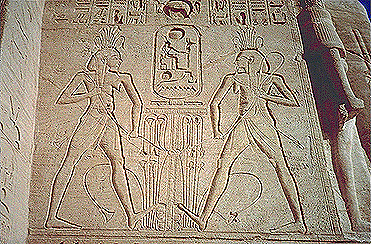Institute of Egyptian Art & Archaeology
Abu Simbel

Relief of Hapi from the Great Temple at Abu Simbel
From the side of the throne of one of the colossal seated statues of Ramesses II that flanks the entrance to the temple.
At Abu Simbel, below the seat of one of the colossal statues of Ramesses II (c.1279-1213 B.C.E.), is this sunk relief of the god Hapi, the personification of the Nile flood. The figure of Hapi appears twice, tying stems of plants around the hieroglyph for "unite." The extended foot of each Hapi figure rests on the hieroglyph which is a lung from which a windpipe projects straight up from the center, and forming a "T" at the top. On the left Hapi holds stems of the lotus (symbol of Upper Egypt); on the right he holds stems of the papyrus (Lower Egypt). Hapi's crowns also display these plants. Hapi is androgynous (having both male and female characteristics), suggesting the fertility of the land which results from the Nile flood. This androgyny explains his pendant breasts and swollen belly. The centralized image of the lung and windpipe flanked by the two figures of Hapi illustrate the Egyptian concern for balance and order. The cartouche of Ramesses II sits directly above the lung and windpipe.
